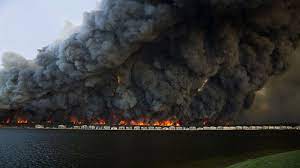You may have heard the term aerosóis in discussions about pollution or climate change, but what exactly are aerosóis?As particles suspended in the air, aerosóis have a profound impact on both the environment and human health.Aerosóis are microscopic solid particles or liquid droplets that remain suspended in the air for at least several seconds.They are created naturally through processes like sea spray, wildfires, and volcanic eruptions, but human activity has increased atmospheric aerosol concentrations exponentially over the past century.The effects of aerosóis are wide-ranging, from influencing the climate by interacting with sunlight and clouds, to threatening public health by penetrating deep into the lungs.Understanding aerosóis is crucial to addressing some of the greatest challenges facing our world today.This article will explore what aerosóis are, their sources and impacts, and how scientists study them to better understand and mitigate their effects.
Introduction
Aerosóis are suspensions of fine solid particles or liquid droplets in a gas, typically air. The particles are small enough that their motion is primarily determined by collisions with gas molecules, giving them properties of gasses. However, their collective behavior is determined by particle-particle collisions, giving them properties of liquids or solids.
Aerosóis have diameters ranging from a few nanometers to 100 micrometers. They remain suspended in air for long periods due to their small size and mass. Common examples of aerosóis include smoke, mist, fumes, dust, and sea spray. Natural aerosóis are produced by volcanic eruptions, dust storms, forest fires, and living vegetation. Anthropogenic aerosóis are produced by human activities such as the burning of fossil fuels, industrial emissions, and farming.
Aerosóis have significant impacts on the environment, climate, and human health. They scatter and absorb light, influencing the earth’s radiation balance and climate. They provide surfaces for chemical reactions to occur and enable the transport of compounds between the atmosphere and biosphere. Aerosóis also have adverse health effects when inhaled, including respiratory and cardiovascular diseases.
Understanding aerosóis and how to mitigate their effects is crucial for developing sustainable policies and technologies for the future. Studying their sources, properties, transformations, and impacts across spatial and temporal scales remains an active area of research.
The History of Aerosóis
The aerosol can has a long and rich history spanning several decades. Originally invented in Norway in 1927, aerosol cans were first used to dispense insecticides and other pesticides. The technology gradually improved over the following decades, allowing aerosol cans to dispense a wider range of products.
The Post-World War II Boom
After World War II, aerosol can production and use grew rapidly. Several factors drove this boom:
- Improved propellants: The development of liquefied petroleum gasses like propane and butane as propellants allowed aerosol cans to dispense products more forcefully and evenly.
- Aluminum cans: Cans made of aluminum, rather than steel, helped make aerosol cans lighter, less expensive, and easier to produce.
- Economic prosperity: Strong post-war economies in North America and Western Europe fueled demand for new consumer products, including aerosolized goods.
By the 1950s, aerosol cans were used for a plethora of household products like air fresheners, deodorants, hair sprays, and cleaning solutions. This was the golden age of aerosol cans, with sales peaking in the 1970s.
Environmental and Health Concerns
However, concerns arose in the 1970s about the environmental and health impacts of chlorofluorocarbons (CFCs) and other aerosol propellants. In response, more eco-friendly propellants were developed and some CFC uses were banned. Despite these changes, aerosol cans remain popular today for dispensing many personal, household and industrial products in an efficient and controlled manner.
How Aerosóis Works
Aerosóis works by releasing a fine mist or spray of droplets into the air. The aerosol can contains the product and a propellant under pressure. When the nozzle is pressed, the propellant forces the product up a dip tube and out through the nozzle, creating an aerosol.
Propellants
The propellants used are usually liquefied gasses like propane, butane, isobutane or propellants that are a blend of these gasses. As the propellant vaporizes, it pressurizes the can and forces the product out when the nozzle is activated. The propellant completely vaporizes as it leaves the can, leaving behind the fine mist of product droplets suspended in the air.
Droplet size
The droplet size is a key factor in an aerosol product. Droplets that are too large will fall out of suspension too quickly, while droplets that are too small may remain airborne for too long or be difficult to apply accurately. The ideal droplet size depends on the specific product and intended use. Aerosol engineers can control droplet size based on factors like:
- The propellant
- The product being dispensed
- Nozzle design
- Valve specifications
Properly controlling these factors allows engineers to create an aerosol product with droplets in the optimal size range for its purpose.
Uses
Aerosol products have many uses and can be found in applications like:
- Deodorants and air fresheners
- Paints and lubricants
- Insecticides and pesticides
- Sunscreens and hairsprays
The versatility and convenience of aerosol products have led to their widespread popularity and adoption for a range of commercial and industrial uses. Their portability and ability to quickly and evenly dispense products in a fine mist make them well-suited for many purposes.
Types of Aerosóis Products
There are several types of aerosol products commonly available for consumer and industrial use.
Propellants
The contents of an aerosol product are released from the can by propellants, usually pressurized gasses like propane, butane, isobutane or propane-butane mixtures. These liquefied petroleum gasses vaporize and build up pressure to push out the product contents. Propellants are usually odorless, colorless and leave no residue.
Solvents
Many aerosol products contain solvents, liquids that can dissolve other substances. Common solvents include acetone, methanol, and toluene. Solvents aid in dispersing the product contents and carrying other dissolved or suspended ingredients. They evaporate quickly, leaving the remaining product ingredients behind. Solvents must be properly matched to the product to avoid damaging some ingredients or the aerosol can itself.
Propellent-solvent systems
Some aerosol products use a blend of propellants and solvents to create an optimal delivery system. The propellants provide pressure and force, while the solvents help disperse and distribute the product. These systems are carefully engineered to ensure proper distribution, flow and drying of the product while avoiding chemical interactions that could damage the aerosol container.
Active ingredients
The specific active ingredients in an aerosol product provide its intended effects. These include chemicals, pigments, lubricants, adhesives, pesticides, fragrances and other substances. Active ingredients are dissolved, suspended or mixed into the propellant-solvent system so they can be sprayed onto surfaces or into the air. The active ingredients ultimately determine the purpose and properties of the aerosol product.
Choosing the appropriate combination of propellants, solvents and active ingredients for an aerosol product requires extensive testing and engineering to achieve the desired results. Aerosol technology allows for convenient and targeted delivery of a wide range of ingredients and provides options for many consumer, commercial and industrial applications.
The Environmental Impact of Aerosóis
Aerosol products have been shown to negatively impact the environment in several ways:
Depletion of the Ozone Layer
Aerosol propellants often contain chlorofluorocarbons (CFCs), hydrochlorofluorocarbons (HCFCs) and hydrofluorocarbons (HFCs) which deplete the ozone layer. The ozone layer protects the Earth from harmful ultraviolet (UV) radiation from the sun. As the ozone layer thins, more UV radiation reaches the Earth’s surface. This can have damaging effects on human health, agriculture, and natural ecosystems.
Pollution and Health Impacts
The propellants and solvents in aerosol products release volatile organic compounds (VOCs) into the atmosphere which can cause air pollution and smog. VOCs and aerosol particulates may cause respiratory problems and other health issues. Metered dose inhalers (MDIs) used for medical purposes also release CFCs and HFCs which contributes to ozone depletion.
Litter and Waste
People often do not recycle the containers used for aerosol products, and they end up in landfills, waterways, and as litter. The propellants and solvents they contained can contaminate soil and groundwater. Plastic microbeads used in some cosmetic aerosol products pollute the environment and harm wildlife.
Climate Change
CFCs, HCFCs and HFCs are also potent greenhouse gasses that contribute to global climate change. When released into the atmosphere, these gasses trap heat and warm the planet. Reducing and eliminating the use of these chemicals in aerosol propellants and all products can help mitigate climate change.
In summary, aerosol products have had substantial negative consequences on the environment due to ozone depletion, pollution, waste, and climate change. Transitioning to more sustainable alternatives and propellants can help address these pressing issues. Improved recycling of aerosol containers may also reduce waste and pollution over time. Overall, consumers and manufacturers should consider more environmentally-friendly options to aerosol products when possible.
Conclusion
As you have learned, aerosols are suspensions of solid or liquid particles in air or another gas. When a liquid or solid breaks up into tiny droplets or particles and disperses into a carrier gas, they create aerosols.. Aerosols are all around us in the form of fog, smoke, and air pollution but also have many useful applications like in aerosol cans, air fresheners, and inhalers. Now that you understand what aerosols are and how diverse they can be, you can appreciate their ubiquity and importance in the world. Though some can negatively impact health and the environment, aerosols will likely continue to enable new technologies and improve lives when properly harnessed and regulated.
Note:
Are you a content creator? If yes then we welcome bloggers & they can submit a guest post to our famous blog for free, just search in google, we are on top of search engine “ write for us + travel”, You will find “Lifeyet News”.
 Lifeyet News Lifeyet News
Lifeyet News Lifeyet News





